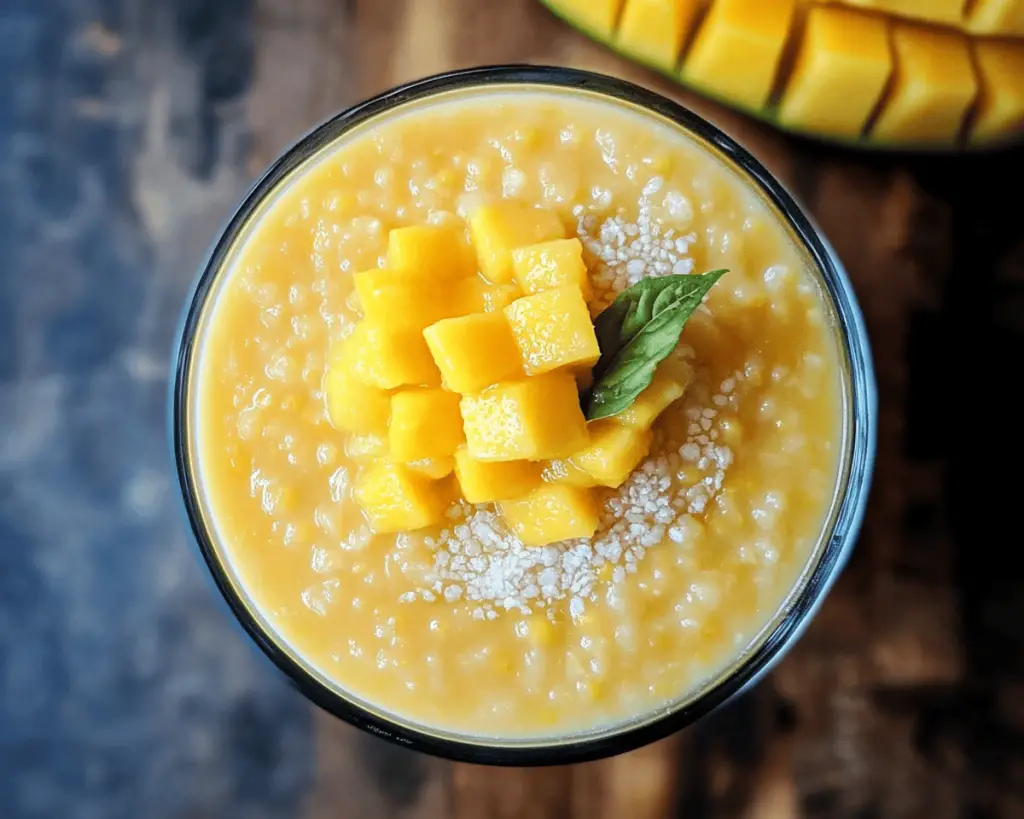Ah, Mango Sago! Just the thought of it makes my taste buds dance with excitement. This delightful dessert holds a special place in my heart, intertwined with memories of summer days spent in my grandma’s kitchen. She would whip up this creamy, luscious treat using the ripest mangoes from the local market, and I can still hear her laughter as I eagerly waited for it to chill. There’s something so uniquely refreshing and satisfying about the sun-kissed mangoes mingling with the softness of sago pearls; it’s like a tropical vacation in a bowl!
What I love most about Mango Sago is how versatile it is! You can adjust the sweetness, swap in different fruits, or even modify the textures. It’s the perfect dish for impressing guests or just treating yourself after a long day. Trust me, once you dig into this creamy, fruity goodness, you’re going to want to make it again and again!
What’s in Mango Sago?
Mangoes: The star of the show! Choose ripe, sweet mangoes for the best flavor. I typically go for the Ataulfo variety because they’re buttery and incredibly sweet. But honestly, any ripe mango will work wonders.
Sago Pearls: These tiny, chewy pearls give the dessert its unique texture. You can usually find them at Asian supermarkets. I recommend the small, white sago pearls because they cook up beautifully and give a lovely mouthfeel.
Coconut Milk: This is where the creaminess comes in! I prefer using full-fat coconut milk for a rich, indulgent taste, but light coconut milk works fine if you want something a bit lighter.
Sugar: This sweetener is crucial for bringing out the mango flavors. Adjust the amount to your preference, depending on how sweet your mangoes are.
Water: Used to cook the sago pearls and mix with the coconut milk for a smooth consistency.
Is Mango Sago Good for You?
You might be happy to hear that Mango Sago isn’t just delicious; it has some health benefits too!
Mangoes: These vibrant fruits are packed with vitamins A and C, which are great for your skin and immune system. Plus, they contain fiber to keep things moving!
Sago Pearls: While sago is primarily composed of carbohydrates, it provides energy and is gluten-free! Just keep in mind that it’s not a high-protein food, so balance it with other nutrient-rich ingredients if you’re looking for a complete meal.
However, keep an eye on the coconut milk and sugar levels. While coconut milk is nutritious, using too much can turn this dessert into a calorie bomb. Moderation is key, as always!
Ingredients
– 2 ripe mangoes (about 3 cups after diced)
– 1/2 cup sago pearls
– 1 can (400ml) full-fat coconut milk
– 3-4 tablespoons sugar (adjust to taste)
– 2 cups water (for cooking sago)
– Optional: additional mango cubes for garnish
*Serves: 4-6*
How to Make Mango Sago?
1. Start by cooking the **sago pearls**. In a pot, bring 2 cups of water to a boil. Slowly add the sago pearls and stir gently. Lower the heat and simmer for about 15 minutes, stirring occasionally until the pearls are translucent.
2. Once the sago is cooked, turn off the heat and cover the pot. Let it sit for another 10 minutes to fully absorb the water. Drain the cooked sago in a fine-mesh sieve and rinse under cold water to stop the cooking process.
3. In a mixing bowl, combine your diced **mangoes** (reserve a few pieces for topping), the **cooked sago**, **coconut milk**, and **sugar**. Stir well until everything is nicely mixed, and taste to adjust the sweetness.
4. Transfer the mixture into serving bowls (or fancy dessert glasses for a beautiful presentation). Chill in the refrigerator for at least an hour to meld the flavors.
5. Before serving, top with additional cubes of fresh mango and maybe a dollop of whipped cream if you’re feeling indulgent!
The Sweet Side of Mango Sago
Here are a few tips and variations to take your Mango Sago to the next level:
– For a bit of crunch, sprinkle some toasted coconut or nuts on top before serving.
– Try adding other fruits like strawberries or kiwi for some beautiful color contrasts.
– If you’re craving a splash of acidity, a squeeze of lime juice can elevate the mango flavor beautifully!
I really hope you try making this delicious Mango Sago! It’s such a crowd-pleaser and a fantastic way to savor the summertime vibes. Please, when you whip it up, share your thoughts and any creative twists you put on it! I can’t wait to hear about your delicious adventures in the kitchen. Enjoy!



